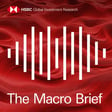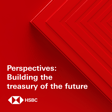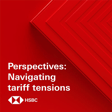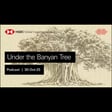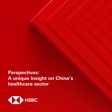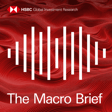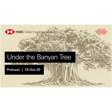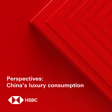Become a Creator today!Start creating today - Share your story with the world!
Start for free
00:00:00
00:00:01

The Macro Viewpoint - China’s charge, Fed hikes, European FX
Jing Liu looks at whether China’s economic momentum can continue, Ryan Wang assesses the path for US monetary policy following the latest Fed rate hike and Dominic Bunning explains why it could be a good summer for the euro and sterling. Disclaimer: https://www.research.hsbc.com/R/51/K92Vmn9 Stay connected and access free to view reports and videos from HSBC Global Research follow us on LinkedIn https://www.linkedin.com/feed/hashtag/hsbcresearch/ or click here: https://www.gbm.hsbc.com/insights/global-research.
Hosted on Acast. See acast.com/privacy for more information.
Transcript
Introduction and Podcast Details
00:00:01
Speaker
Welcome to HSBC Global Viewpoint, the podcast series that brings together business leaders and industry experts to explore the latest global insights, trends, and opportunities.
00:00:13
Speaker
Make sure you're subscribed to stay up to date with new episodes.
00:00:16
Speaker
Thanks for listening, and now onto today's show.
00:00:23
Speaker
This podcast was recorded for publication on the 5th of May 2023.
00:00:27
Speaker
All the disclosures and disclaimers associated with it must be viewed on the link attached to your media player.
Hosts and Economic Topics
00:00:35
Speaker
Hello, I'm Piers Butler in London.
00:00:37
Speaker
And I'm Aline Van Dyne in New York.
00:00:40
Speaker
Coming up on today's program, we look at whether China's economic recovery can sustain its momentum and the implications for growth.
00:00:47
Speaker
We assess the path for U.S. monetary policy following another rate hike by the Federal Reserve.
00:00:55
Speaker
And we find out why it could be a good summer for the euro and sterling.
China's Economic Recovery
00:01:02
Speaker
We begin this week in Asia, where China's economic recovery is well underway.
00:01:07
Speaker
Growth in the first quarter came in stronger than expected, prompting our economics team to raise their forecast for this year.
00:01:13
Speaker
Jing Liu is chief economist for Greater China.
00:01:16
Speaker
She spoke to Graham Mackay earlier.
00:01:19
Speaker
Jing, welcome to the podcast.
00:01:20
Speaker
Great to have you.
00:01:21
Speaker
Thanks for having me here again.
00:01:23
Speaker
So a new GDP forecast for mainland China.
00:01:28
Speaker
What have you done?
00:01:28
Speaker
Have you gone up, down?
00:01:30
Speaker
We actually revised up our forecast for 2023 to 6.3% from 5.6%.
00:01:33
Speaker
And next year, we're now seeing a 5.0% revised down from the previous forecast of 5.5%.
00:01:47
Speaker
Okay, so up for this year, down for 2024.
00:01:51
Speaker
Why is that?
00:01:52
Speaker
So we can see this is a more front-loaded recovery than we previously thought.
00:01:58
Speaker
The first quarter GDP number and activity data in general basically confirm the recovery is swifter than we thought before.
00:02:08
Speaker
So first quarter already registered 4.5% GDP growth and largely driven by the performance from the consumption, the survey sector in particular.
00:02:20
Speaker
Okay, and is this still an almost exclusively consumption-driven recovery?
00:02:26
Speaker
I mean, I know things like, for example, property are never too far away from the conversation, but is it really about consumption as the focal point of this recovery?
00:02:34
Speaker
We see this more like organic growth in the sense that after reopening, similar as in other economies, we see that the service rebound almost instantaneously.
00:02:47
Speaker
And because the service sectors are booming, it start to recruit more people.
00:02:53
Speaker
Jobs are back, stable income is back, so people start to consume goods as well.
00:03:01
Speaker
We have seen the green shoots on the property sector, in particular, March we have seen in the year-on-year terms,
00:03:10
Speaker
transaction volume as well as the prices in some big cities already see the upward trend so after many months of contraction so that's a positive and also we see the property investment still in the contraction but less than before we have also seen in certain cities the land auction start to
00:03:37
Speaker
hit the upper bound, indicating the developers start to become more positive about the outlook.
00:03:44
Speaker
So we remain constructive by seeing the mild rebound as a base case for this year.
00:03:51
Speaker
So at least the property sector will no longer be a drag to the GDP growth.
00:03:55
Speaker
Okay, so would it be fair to say overall that the recovery is still very much focused on domestic demand rather than, say, exports?
00:04:03
Speaker
Yeah, that's fair to say.
00:04:04
Speaker
We see the upside surprise in March on export, but overall we think this year most of the driver would come from the domestic force, including the consumption we have discussed.
00:04:17
Speaker
And on the infrastructure and manufacturing investment side, we are forecasting around 5% of the growth this year for both categories.
00:04:27
Speaker
So domestic driven recovery is playing out in China.
00:04:33
Speaker
And do you see this more, as you put it, more front-loaded consumption recovery having any implications for how monetary or fiscal policy could play out?
00:04:43
Speaker
Or are your expectations there much the same as they were before?
00:04:47
Speaker
Our expectation is pretty much the same.
00:04:49
Speaker
We still see the lockstep policy support and then the pro-growth mentality was confirmed again in last week's Politburo meeting.
00:05:00
Speaker
Basically, we expect the policies to stay constructive because we still see the pressure in different perspectives, such as still elevated youth unemployment rate
00:05:13
Speaker
And also the external demand likely will continue to soften along the years.
00:05:19
Speaker
Jing Liu, thank you very much indeed, as ever, for joining us.
00:05:22
Speaker
Thank you.
U.S. Monetary Policy and Market Reactions
00:05:26
Speaker
Now here in the U.S., the Federal Reserve continued its tightening cycle with another 25 basis point rate rise, taking the Fed Fund's target range above 5 percent for the first time since 2007.
00:05:41
Speaker
Will policymakers now pause or could we see even more hikes?
00:05:47
Speaker
Ryan Wang, U.S. economist, can tell us more.
00:05:50
Speaker
Ryan.
00:05:52
Speaker
Fill us in with exactly what the tone was from the FOMC this time.
00:05:58
Speaker
Hi, Aline.
00:05:59
Speaker
Well, I think the clearest message came from Fed Chair Jerome Powell during the press conference.
00:06:04
Speaker
He talked about the sense of the policymakers on the FOMC being that perhaps we are closer to the end of the rate hike cycle rather than to the beginning.
00:06:15
Speaker
Now,
00:06:16
Speaker
That doesn't necessarily mean we're done with rate increases.
00:06:19
Speaker
It will depend on the incoming economic data.
00:06:22
Speaker
It will depend on various developments and risks.
00:06:25
Speaker
And for our own part, we continue to expect a final 25 base point rate hike in June.
00:06:31
Speaker
Ryan, let's get into that a bit more because parts of the market are already pricing in rate cuts this year.
00:06:39
Speaker
You're not expecting that.
00:06:41
Speaker
What exactly is the reason?
00:06:43
Speaker
Right.
00:06:43
Speaker
Well, this question about not only the peak for policy rates, but also the prospect of rate cuts potentially later this year is a complicated one because it depends on the interaction
00:06:56
Speaker
of an FOMC that's still trying to bring inflation lower.
00:06:59
Speaker
Inflation has remained stubbornly elevated.
00:07:02
Speaker
But at the same time, the policymakers are also considering a variety of risks.
00:07:07
Speaker
There are risks stemming from developments in the banking sector.
00:07:10
Speaker
There are risks related to what that might do to credit conditions and the impact that that might have on the economy.
00:07:15
Speaker
And there are near-term risks related to the current debt limit impasse.
00:07:20
Speaker
So it's this balance between these risks against the persistence of elevated inflation that's going to be the key driver of the FOMC's decisions, not only at the June policy meeting, but over the year ahead.
00:07:35
Speaker
Looking into the coming weeks, what data points are going to be particularly important?
00:07:41
Speaker
Well, in the next few weeks, we'll be looking at the April figures on jobs, on inflation, on retail sales.
00:07:50
Speaker
We will get the results of the senior loan officer survey on lending practices, which will give us some idea in a quantitative sense about the proportion of banks that may be tightening their credit standards.
00:08:05
Speaker
And so these will all be important.
00:08:07
Speaker
And the Fed is still facing a challenging situation when it comes to the tightness of the labor market and the impact that that's having on both wage pressures and inflation.
00:08:20
Speaker
We'll be waiting to see whether that changes in the data over the weeks ahead.
Debt Ceiling Negotiations and Institutional Events
00:08:24
Speaker
And lastly, Ryan, any insights on the issue around the U.S. debt ceiling, whether or not the U.S. may be able to continue borrowing?
00:08:34
Speaker
Well, I think the next key date on this topic, which could be very important for markets, will be on May the 9th, when we will have a meeting between President Biden and House Speaker Kevin McCarthy.
00:08:50
Speaker
We'll be waiting to see whether bipartisan negotiations pick up any steam after that meeting.
00:08:56
Speaker
And in the meantime, we'll be also monitoring
00:08:59
Speaker
the daily cash flows reported by the Treasury to see whether the 1st of June date that has been flagged is going to be a key risk for markets.
00:09:10
Speaker
Ryan, thank you so much.
00:09:12
Speaker
Thank you, Aline.
00:09:16
Speaker
A quick reminder now for HSBC Global Research clients.
00:09:20
Speaker
Voting for the annual Institutional Investor Survey closes on the 5th of May.
00:09:25
Speaker
We really appreciate your support.
00:09:27
Speaker
So if you value the information, insights and ideas that we provide, please participate in the survey.
00:09:35
Speaker
The web address that you need is voting.institutionalinvestor.com.
European Economic Outlook
00:09:46
Speaker
Now in Europe, the ECB has also just held its latest meeting.
00:09:50
Speaker
What happened, Piers?
00:09:52
Speaker
Well, Aileen, the banks slowed the pace of their rate hikes with a 25 basis point rate rise, taking the deposit rate to 3.25%.
00:10:01
Speaker
Our European economics team expects a further 25 basis point hike in June before a pause.
00:10:07
Speaker
And sticking with the European theme, we finished this week in the currency markets where our team has been positive on the euro and sterling since the end of last year.
00:10:16
Speaker
As we head towards the summer, Dominic Bunning, head of European FX Research, has been assessing their prospects and he joins me in the studio now.
00:10:23
Speaker
Dominic, welcome to the podcast.
00:10:25
Speaker
Thanks, Piers, and thanks for saving the best till last.
00:10:28
Speaker
Absolutely.
00:10:30
Speaker
Firstly, remind us of your thesis behind this bullish stance on the euro and sterling.
00:10:34
Speaker
Yeah, so we'd some more bullish on both the euro and sterling back in November.
00:10:39
Speaker
A big part of that was that we thought the dollar had peaked and sort of the flip side of the dollar peaking and the likely rebound in global risk appetite and those sorts of things, that was going to be quite bullish for euro and sterling.
00:10:51
Speaker
But I think we're seeing some signs of some idiosyncratic factors now becoming more positive as well.
00:10:57
Speaker
Indeed.
00:10:57
Speaker
So we're shifting from some sort of global perspective towards some more localised phenomena.
00:11:02
Speaker
Can you sort of run us through those?
00:11:04
Speaker
Yeah, absolutely.
00:11:04
Speaker
So the first thing we've noticed is if you look at the relationship of the currencies versus global risk appetite and versus rate differentials, we're seeing that shift towards rate differentials mattering more.
00:11:15
Speaker
And that's a sign that that local story is becoming more important.
00:11:19
Speaker
And when we look at some of those local factors, we see really strong rebounds in consumer confidence, and that's tended to be a good lead indicator of currency performance for both the euro and sterling.
00:11:30
Speaker
We're seeing PMI, so businesses showing much more optimism as well.
00:11:34
Speaker
And we're also seeing some big signs of disinflation.
00:11:37
Speaker
And what we're really talking about here is a big reversal
00:11:40
Speaker
of the negative pressures that came about in 2022.
00:11:44
Speaker
So growth is starting to pick up locally.
00:11:46
Speaker
Inflation is softening a little bit, and that provides quite an optimistic picture for both the euro and for sterling during the summer months.
00:11:53
Speaker
Any clouds on the horizon to spoil that rosy summer view?
00:11:58
Speaker
Yeah, there are some risks, absolutely.
00:12:00
Speaker
You know, if you look at particularly the credit cycle, there's definitely some signs here that credit demand is slowing, credit growth is slowing.
00:12:08
Speaker
And that's something that the ECB has spoken about briefly and is ultimately a cause or an effect, sorry, of all of the policy tightening we've seen.
00:12:17
Speaker
But it's not in our view going to be enough for now to drag down that near term momentum.
00:12:21
Speaker
So looking beyond the summer, I do have some concerns that credit story could be a bit more challenging, make that growth outlook a bit more difficult.
00:12:29
Speaker
And that's why, you know, by the end of the summer, it might be harder for the Euro and Sterling to keep extending those gains.
00:12:35
Speaker
But for now, I still think it's a pretty sunny outlook.
00:12:38
Speaker
Very good.
00:12:38
Speaker
Thanks, Dominic, for joining us today.
00:12:40
Speaker
Thanks very much.
00:12:43
Speaker
So that's it for another week.
00:12:45
Speaker
Thanks to our guests, Jing Liu, Ryan Wang and Dominic Bunning.
00:12:48
Speaker
From all of us here, thanks for listening.
00:12:51
Speaker
We'll be back again next week.
00:13:12
Speaker
Thank you for joining us at HSBC Global Viewpoint.
00:13:16
Speaker
We hope you enjoyed the discussion.
00:13:18
Speaker
Make sure you're subscribed to stay up to date with new episodes.
